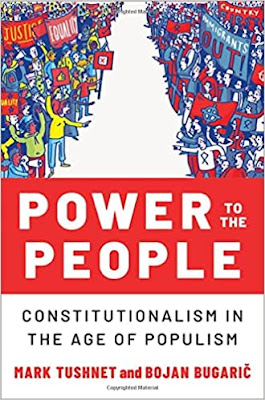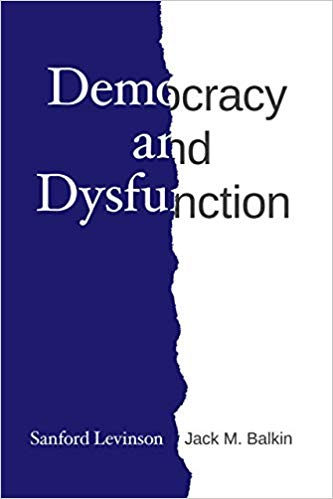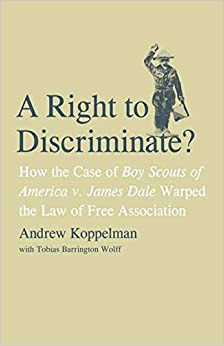Balkinization
an unanticipated consequence of
Jack M. Balkin
Balkinization Symposiums: A Continuing List
E-mail:
Jack Balkin:
jackbalkin at yahoo.com
Bruce Ackerman
bruce.ackerman at yale.edu
Ian Ayres
ian.ayres at yale.edu
Corey Brettschneider
corey_brettschneider at brown.edu
Mary Dudziak
mary.l.dudziak at emory.edu
Joey Fishkin
joey.fishkin at gmail.com
Heather Gerken heather.gerken at yale.edu
Abbe Gluck abbe.gluck at yale.edu
Mark Graber
mgraber at law.umaryland.edu
Stephen Griffin
sgriffin at tulane.edu
Jonathan Hafetz
jonathan.hafetz at shu.edu
Jeremy Kessler
jkessler at law.columbia.edu
Andrew Koppelman
akoppelman at law.northwestern.edu
Marty Lederman
msl46 at law.georgetown.edu
Sanford Levinson
slevinson at law.utexas.edu
David Luban
david.luban at gmail.com
Gerard Magliocca
gmaglioc at iupui.edu
Jason Mazzone
mazzonej at illinois.edu
Linda McClain
lmcclain at bu.edu
John Mikhail
mikhail at law.georgetown.edu
Frank Pasquale
pasquale.frank at gmail.com
Nate Persily
npersily at gmail.com
Michael Stokes Paulsen
michaelstokespaulsen at gmail.com
Deborah Pearlstein
dpearlst at yu.edu
Rick Pildes
rick.pildes at nyu.edu
David Pozen
dpozen at law.columbia.edu
Richard Primus
raprimus at umich.edu
K. Sabeel Rahmansabeel.rahman at brooklaw.edu
Alice Ristroph
alice.ristroph at shu.edu
Neil Siegel
siegel at law.duke.edu
David Super
david.super at law.georgetown.edu
Brian Tamanaha
btamanaha at wulaw.wustl.edu
Nelson Tebbe
nelson.tebbe at brooklaw.edu
Mark Tushnet
mtushnet at law.harvard.edu
Adam Winkler
winkler at ucla.edu
Compendium of posts on Hobby Lobby and related cases
The Anti-Torture Memos: Balkinization Posts on Torture, Interrogation, Detention, War Powers, and OLC
The Anti-Torture Memos (arranged by topic)
Recent Posts
"Regular Forces:" A Lesson in the Obvious
Just A Few Blogs
ACS Blog
Alas, a Blog
Althouse
Arts and Letters Daily
Atrios (Eschaton)
Bill of Health
Buzzflash.com
Buzz Machine
Cato at Liberty
Juan Cole (Informed Comment)
Concurring Opinions
The Constitution in 2020
Corrente
Crooked Timber
Daily Howler
Daily Kos
Dana Boyd
Brad DeLong
Digby (Hullabaloo)
Discriminations
Daniel Drezner
Kevin Drum (Mother Jones)
Electrolite
En Banc
Eunomia (Daniel Larison)
Fafblog
Michael Froomkin (Discourse.net)
GovLab (Beth Noveck)
Rick Hasen (Election Law)
History News Network
How Appealing
Ignatz (Sam Heldman)
The Importance of (Ernie Miller)
Infolaw
Instapundit
International Economic Law and Policy Blog
IntLawGrrls
Jacob Levy
Jesus' General
Jurisdynamics
The Kitchen Cabinet
Mark Kleiman
Law Blog Central
Larry Lessig
Lawyers, Guns and Money
Liberal Oasis
Brian Leiter's Law School Reports
The Leiter Reports
Marginal Revolution
Megan McArdle
Memeorandum
Metafilter
Mirror of Justice
The New Republic
Newseum
No More Mister Nice Blog
Brendan Nyhan
Opinio Juris
Orcinus
The Originalism Blog
Pandagon
Passport (Foreign Policy)
Overcoming Bias
Political Animal (Washington Monthly)
Political Theory Daily Review
Political Wire (Taegan Goddard)
The Poor Man
Virginia Postrel
Prawfsblawg
Public Reason
Jonathan Rauch
Raw Story
Redstate
ReligiousLeftLaw.com
Reporters Committee For Freedom of the Press
Reproductive Rights Blog
Rothman's Roadmap to the Right of Publicity
SCOTUS Blog
Seeing the Forest
Clay Shirky
The Shifted Librarian
The Situationist
Larry Solum (Legal Theory)
Andrew Sullivan
Talking Points Memo
Talk Left
Tapped
Tbogg
TechPresident
The Paper Chase (Jurist)
Tom Paine
Tom Tomorrow (This Modern World)
Eve Tushnet
Uggabugga
University of Chicago Law School Faculty Blog
Unqualified Offerings
The Volokh Conspiracy
War and Piece (Laura Rozen)
Wampum
Oliver Willis
Wonkette
Written Description
Matthew Yglesias
Yin
Your Choice of Feeds
1. XML
powered by
2. Atom Feed
3. RSS 2.0
Wednesday, November 05, 2025
"Regular Forces:" A Lesson in the Obvious
Mark Graber
The Supreme Court’s order in Trump
v. Illinois asked the parties to the dispute over whether President Trump
could constitutionally federalize state militia to enforce federal immigration
laws in Chicago to address “whether the term ‘regular forces’” in 10 U. S. C.
§12406(3) “refers to the regular forces of the United States military” or, as
the Trump administration claims, civilian law enforcement personnel. The relevant text of 1908 revisions to the Dick Act (1903) declares, “Whenever . . . the President is unable with
the regular forces at his command to execute the laws of the United States; the President may
call into Federal service members and units of the National Guard of any State
in such numbers as he considers necessary to repel the invasion, suppress the
rebellion, or execute the laws.” Both
common sense and context support “regular forces” referring to the regular
forces of the United States military, who are responsible for repelling
invasions and suppressing rebellions.
Marty Lederman has a terrific brief demonstrating that the persons
responsible for this 1908 language consistently used “regular forces” to refer
to the regular forces of the United States and never used that phrase to refer
to civilian law enforcement. My survey
of newspapers published at the time confirms Lederman’s findings. Over
the weekend, I began a survey of every use of “regular forces” I could find in
newspapers published in 1908. I started
my survey with GenealogyBank, although plan is to examine Newspapers.com and
NewspaperArchive as well. There were
245 hits on GenealogyBank, of which I have reviewed 100. This blog post will be updated as I review
more articles, but the findings below are likely to be robust. Eighty
of the one-hundred uses of “regular forces" in the newspapers surveyed referred to the regular forces of the United
States military, 7 occurred in articles that excerpted the 1908 statute without
commentary, and 13 had other references.
No newspaper clearly used “regular forces” to refer to civilian law
enforcement. The June 24, 1908, edition
of the Coeur d’Alene Evening Press (ID) is typical. In an article entitled, “For Army of 250,000 Men,”
the paper quoted General Robert Shaw Oliver as declaring, “What we propose to
do is to organize these state troops and all the regular forces into eight army
corps.” The Morning Tribune (Providence,
RI) on January 14, 1908, spoke of the “merger of the volunteer and regular
forces.”
Many newspapers used “regular
forces” to refer to the regular forces of the United States military when
discussing military training exercises. The
July 1, 1908, edition of the Watertown Daily Times (NY) reported that “the
regular forces this morning were divided into two armies.” Many of these newspaper stories concerned
joint exercises featuring the regular army and state militia. The Evening News of Providence, Rhode
Island on May 12, 1908, anticipated “two weeks of field maneuvers in which the
national guard and the regular forces take part.” The Baltimore American on December 10
reported that after watching and being briefed on those joint maneuvers, President Theodore Roosevelt
was “warm in praise of the National Guard in conjunction with the regular
forces.” Several
newspapers used “regular forces” to refer to the regular forces of the United
States military when discussing the 1908 revisions to the Dick Act that made
the above reference to “regular forces.”
The Buffalo Evening News (NY) on January 20, 1908, asserted that
the proposed revisions would raise the state militia “from the humiliating
position in which it found itself at the outbreak of the Spanish-American War,
a body of troops with no official standing or privileges, to a position of
equality with the regular forces.” The January 11, 1908, edition of The Daily Nonpareil (Council Bluffs,
IA) declared that the Dick Act and subsequent revisions would “conform” the
state militia’s “organization, armament, and discipline to that prescribed for
the regular forces of the United States.”
Several newspapers reported on a different section of the revisions to
the Dick Act which more clearly used “regular forces” to refer to the regular
military forces of the United States. The
Providence Sunday Journal (RI) on September 27, 1909,quoted the language of Section 5: —“when the
military needs of the Federal Government arising from the necessity to execute
the laws of the Union, suppress insurrection or repel invasion, cannot be met
by the regular forces, the organized militia shall be called into the service
of the United States.” The army repels invasions, not civilian law enforcement. With
one possible exception, none of the thirteen uses of “regular forces” in 1908 newspapers that
did not refer to the regular army or quote the language of federal law referred to civilian law enforcement. Most
used “regular forces” to refer to permanent employees. “The Montgomery Advertizer (AL) on
September 4, 1908, spoke of “regular forces of stores, factories and other
houses.” The Baltimore American on
March 12, 1908, referred to permanent employees of the railroad as “regular
forces.” The one possible exception is an article in the February 27, 1908 ,Philadelphia
Inquirer that stated, “One lieutenant, three sergeants and a squad of fifty
policemen from the reserve and regular forces responded to the call.” The context suggests that “regular
forces” referred to “permanent employees” (as opposed to the “reserve” forces)
and not that civil law enforcement officials were part of the “regular forces”
of the United States, a reference made by no newspaper surveyed. The
newspaper articles indicate that the primary purpose of the new federal
laws was to prepare state militias for military combat. The Buffalo Evening News article
quoted above noted that the Dick Act was inspired by the poor performance of state
militia in the Spanish American War. Many newspapers quoted General Oliver’s
declaration that the point of the Dick Act and revisions was to prepare state
militias “in the event of war.” The
Idaho Register on February 14, 1908, explicitly stated that federal laws
were preparing state militia for military combat and not domestic law
enforcement. the article entitled “State Militia as a Reserve
Force” contended, “The bill amends the existing militia law, so hereafter the
state troops will be looked upon as a part of the system of national defense
rather than an organization for suppression of strikes and internal troubles.” The
survey is ongoing, but no reason exists for thinking reading more newspapers
will change the balance in a scorecard that presently reads 80 papers in favor
of the Illinois interpretation of “regular forces” and 0 for the Trump Administration's interpretation. All that is likely to
happen is Illinois will continue running up the score. A little history provides another reason for
the utter implausibility of the claim that “regular forces” means civilian law
enforcement. In 2025, the president has
access to vast civilian law enforcement agencies such as the Federal Bureau of
Investigation, the Immigration and Customs Enforcement, and the Department of
Homeland Security. Such bureaucracies
either did not exist when the Dick Act was framed or revised or were in their
infancy. The army was the main and
usually the only vehicle for law enforcement when uprisings occurred. A president who could not call on the military
to repel invasions, suppress rebellions and prevent uprisings would in almost
every place in the United States be unable to execute any federal laws. The reference to "regular forces" would have been meaningless in almost all cases.
Posted
3:44 PM
by Mark Graber [link]
Books by Balkinization Bloggers

Linda C. McClain and Aziza Ahmed, The Routledge Companion to Gender and COVID-19 (Routledge, 2024)

David Pozen, The Constitution of the War on Drugs (Oxford University Press, 2024)

Jack M. Balkin, Memory and Authority: The Uses of History in Constitutional Interpretation (Yale University Press, 2024)

Mark A. Graber, Punish Treason, Reward Loyalty: The Forgotten Goals of Constitutional Reform after the Civil War (University of Kansas Press, 2023)

Jack M. Balkin, What Roe v. Wade Should Have Said: The Nation's Top Legal Experts Rewrite America's Most Controversial Decision - Revised Edition (NYU Press, 2023)

Andrew Koppelman, Burning Down the House: How Libertarian Philosophy Was Corrupted by Delusion and Greed (St. Martin’s Press, 2022)

Gerard N. Magliocca, Washington's Heir: The Life of Justice Bushrod Washington (Oxford University Press, 2022)

Joseph Fishkin and William E. Forbath, The Anti-Oligarchy Constitution: Reconstructing the Economic Foundations of American Democracy (Harvard University Press, 2022)

Mark Tushnet and Bojan Bugaric, Power to the People: Constitutionalism in the Age of Populism (Oxford University Press 2021).

Mark Philip Bradley and Mary L. Dudziak, eds., Making the Forever War: Marilyn B. Young on the Culture and Politics of American Militarism Culture and Politics in the Cold War and Beyond (University of Massachusetts Press, 2021).

Jack M. Balkin, What Obergefell v. Hodges Should Have Said: The Nation's Top Legal Experts Rewrite America's Same-Sex Marriage Decision (Yale University Press, 2020)

Frank Pasquale, New Laws of Robotics: Defending Human Expertise in the Age of AI (Belknap Press, 2020)

Jack M. Balkin, The Cycles of Constitutional Time (Oxford University Press, 2020)

Mark Tushnet, Taking Back the Constitution: Activist Judges and the Next Age of American Law (Yale University Press 2020).

Andrew Koppelman, Gay Rights vs. Religious Liberty?: The Unnecessary Conflict (Oxford University Press, 2020)

Ezekiel J Emanuel and Abbe R. Gluck, The Trillion Dollar Revolution: How the Affordable Care Act Transformed Politics, Law, and Health Care in America (PublicAffairs, 2020)

Linda C. McClain, Who's the Bigot?: Learning from Conflicts over Marriage and Civil Rights Law (Oxford University Press, 2020)

Sanford Levinson and Jack M. Balkin, Democracy and Dysfunction (University of Chicago Press, 2019)

Sanford Levinson, Written in Stone: Public Monuments in Changing Societies (Duke University Press 2018)

Mark A. Graber, Sanford Levinson, and Mark Tushnet, eds., Constitutional Democracy in Crisis? (Oxford University Press 2018)

Gerard Magliocca, The Heart of the Constitution: How the Bill of Rights became the Bill of Rights (Oxford University Press, 2018)

Cynthia Levinson and Sanford Levinson, Fault Lines in the Constitution: The Framers, Their Fights, and the Flaws that Affect Us Today (Peachtree Publishers, 2017)

Brian Z. Tamanaha, A Realistic Theory of Law (Cambridge University Press 2017)

Sanford Levinson, Nullification and Secession in Modern Constitutional Thought (University Press of Kansas 2016)

Sanford Levinson, An Argument Open to All: Reading The Federalist in the 21st Century (Yale University Press 2015)

Stephen M. Griffin, Broken Trust: Dysfunctional Government and Constitutional Reform (University Press of Kansas, 2015)

Frank Pasquale, The Black Box Society: The Secret Algorithms That Control Money and Information (Harvard University Press, 2015)

Bruce Ackerman, We the People, Volume 3: The Civil Rights Revolution (Harvard University Press, 2014)
Balkinization Symposium on We the People, Volume 3: The Civil Rights Revolution

Joseph Fishkin, Bottlenecks: A New Theory of Equal Opportunity (Oxford University Press, 2014)

Mark A. Graber, A New Introduction to American Constitutionalism (Oxford University Press, 2013)

John Mikhail, Elements of Moral Cognition: Rawls' Linguistic Analogy and the Cognitive Science of Moral and Legal Judgment (Cambridge University Press, 2013)

Gerard N. Magliocca, American Founding Son: John Bingham and the Invention of the Fourteenth Amendment (New York University Press, 2013)

Stephen M. Griffin, Long Wars and the Constitution (Harvard University Press, 2013)

Andrew Koppelman, The Tough Luck Constitution and the Assault on Health Care Reform (Oxford University Press, 2013)

James E. Fleming and Linda C. McClain, Ordered Liberty: Rights, Responsibilities, and Virtues (Harvard University Press, 2013)
Balkinization Symposium on Ordered Liberty: Rights, Responsibilities, and Virtues

Andrew Koppelman, Defending American Religious Neutrality (Harvard University Press, 2013)

Brian Z. Tamanaha, Failing Law Schools (University of Chicago Press, 2012)

Sanford Levinson, Framed: America's 51 Constitutions and the Crisis of Governance (Oxford University Press, 2012)

Linda C. McClain and Joanna L. Grossman, Gender Equality: Dimensions of Women's Equal Citizenship (Cambridge University Press, 2012)

Mary Dudziak, War Time: An Idea, Its History, Its Consequences (Oxford University Press, 2012)

Jack M. Balkin, Living Originalism (Harvard University Press, 2011)

Jason Mazzone, Copyfraud and Other Abuses of Intellectual Property Law (Stanford University Press, 2011)

Richard W. Garnett and Andrew Koppelman, First Amendment Stories, (Foundation Press 2011)

Jack M. Balkin, Constitutional Redemption: Political Faith in an Unjust World (Harvard University Press, 2011)

Gerard Magliocca, The Tragedy of William Jennings Bryan: Constitutional Law and the Politics of Backlash (Yale University Press, 2011)

Bernard Harcourt, The Illusion of Free Markets: Punishment and the Myth of Natural Order (Harvard University Press, 2010)

Bruce Ackerman, The Decline and Fall of the American Republic (Harvard University Press, 2010)
Balkinization Symposium on The Decline and Fall of the American Republic

Ian Ayres. Carrots and Sticks: Unlock the Power of Incentives to Get Things Done (Bantam Books, 2010)

Mark Tushnet, Why the Constitution Matters (Yale University Press 2010)
Ian Ayres and Barry Nalebuff: Lifecycle Investing: A New, Safe, and Audacious Way to Improve the Performance of Your Retirement Portfolio (Basic Books, 2010)
.jpg)
Jack M. Balkin, The Laws of Change: I Ching and the Philosophy of Life (2d Edition, Sybil Creek Press 2009)

Brian Z. Tamanaha, Beyond the Formalist-Realist Divide: The Role of Politics in Judging (Princeton University Press 2009)

Andrew Koppelman and Tobias Barrington Wolff, A Right to Discriminate?: How the Case of Boy Scouts of America v. James Dale Warped the Law of Free Association (Yale University Press 2009)

Jack M. Balkin and Reva B. Siegel, The Constitution in 2020 (Oxford University Press 2009)
Heather K. Gerken, The Democracy Index: Why Our Election System Is Failing and How to Fix It (Princeton University Press 2009)

Mary Dudziak, Exporting American Dreams: Thurgood Marshall's African Journey (Oxford University Press 2008)

David Luban, Legal Ethics and Human Dignity (Cambridge Univ. Press 2007)

Ian Ayres, Super Crunchers: Why Thinking-By-Numbers is the New Way to be Smart (Bantam 2007)

Jack M. Balkin, James Grimmelmann, Eddan Katz, Nimrod Kozlovski, Shlomit Wagman and Tal Zarsky, eds., Cybercrime: Digital Cops in a Networked Environment (N.Y.U. Press 2007)

Jack M. Balkin and Beth Simone Noveck, The State of Play: Law, Games, and Virtual Worlds (N.Y.U. Press 2006)

Andrew Koppelman, Same Sex, Different States: When Same-Sex Marriages Cross State Lines (Yale University Press 2006)
Brian Tamanaha, Law as a Means to an End (Cambridge University Press 2006)
Sanford Levinson, Our Undemocratic Constitution (Oxford University Press 2006)
Mark Graber, Dred Scott and the Problem of Constitutional Evil (Cambridge University Press 2006)
Jack M. Balkin, ed., What Roe v. Wade Should Have Said (N.Y.U. Press 2005)
Sanford Levinson, ed., Torture: A Collection (Oxford University Press 2004)
Balkin.com homepage
Bibliography
Conlaw.net
Cultural Software
Writings
Opeds
The Information Society Project
BrownvBoard.com
Useful Links
Syllabi and Exams